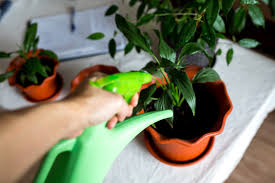How do plants get overwatered?
It
breaks down into two issues: too much water; and, inadequate drainage. Either
or both may happen when too much water is given to plants. It is most
applicable to plants in pots, but can also occur with plants in the ground.
When
you water you are doing a couple of things. You are supplying needed moisture
to the root system so it can provide that moisture to the stems and leaves. You
are also flushing out some minerals and waste products from metabolic processes
occurring in the roots and in the soil. If your potted plants have a drip tray
under them and you leave water in the tray, the waste products have nowhere to
go except back in to the soil where they become more concentrated. This can
lead to soil that is toxic to the roots. Remember that potted plants are in an
essentially closed system—unless you flush out the accumulated salts and waste
products periodically. The minerals in your water supply will accumulate,
possibly to the point of burning the tips of the roots which is “where the
action is” in terms of uptake of nutrients and water.
If
the soil remains saturated after watering, it functions as a barrier to air
movement into the soil. The roots of most plants need oxygen to carry out
growth and metabolism. Overly wet soil prevents this and causes the roots to
wither and/or rot.
There
are a couple of things you can do to avoid the problems of overwatering. First,
let the soil dry out, at least near the surface between watering
s.
Some people water on a schedule, such as once/week. This may be fine during the
warm season, but may be too much water when cooler temperatures slow the
plants’ metabolism. Better to test the soil for dryness by inserting a finger
to a depth of about two inches. If the soil is dry, then you should water.
Second,
don’t let your plants sit with “wet feet.” It is preferable to remove the
plants from their drip trays and water them in the sink or outside with a hose,
flooding the pot, but letting the excess water completely drain before
returning them to their trays. This both eliminates excess water in the soil
and allows accumulated salts and minerals to be at least partially flushed
away.
Something
else to bear in mind, a lot of the plants that are sold for indoor potted
applications are fairly tolerant of either overwatering or under watering.
However, when you water properly you are allowing some of the nutrients in the
soil to be flushed out with the built-up, excess minerals that are in your water.
This can be remedied by the application of low-dose, time-release fertilizer
occasionally. If your plants are not showing much new growth during the most
active growing period (usually spring and summer), it may be time to lightly
fertilize. I usually use a time-release fertilizer with an NPK (nitrogen,
phosphorus and potassium) value of 6–6–6 or close, once a year for most plants.
The P and K is helpful for the roots and for plants that typically flower. For
plants like ferns, just a very dilute nitrogen fertilizer is all they need.
With
some practice, you’ll find that you can gauge the dryness of your plants’ soil
and give them water at optimum times.
https://larixconferences.com/biotechnology/



I was impressed with the customization options PK Medi Engineering offered for our nurse call system. They tailored it specifically to our facility’s layout and workflow. Their team ensured we were trained and ready to use the system effectively. It’s now an indispensable part of our patient care strategy.
ReplyDeleteFor More Details: https://pkmec.com/
Al-Razi provided us with legal-medical expertise during a complex case. Their attention to detail and professionalism made a huge difference.
ReplyDeleteFor More Details: https://alraziconsultants.com/